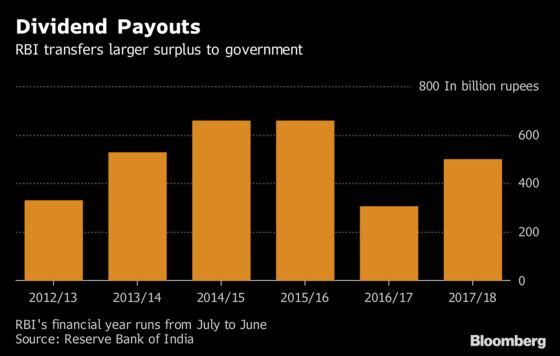Why India's Central Bank Is at Loggerheads With the Government
From a banking crisis to interest rates, the RBI has often found itself on opposing sides to government officials this year.
(Bloomberg) -- A growing rift between India’s central bank and the government has been many months in the making.
In the latest move, the Reserve Bank of India made its disagreement with authorities public in a hard-hitting speech by Deputy Governor Viral Acharya on Friday -- which he said had the backing of Governor Urjit Patel -- defending the central bank’s independence. Failure to do so would “incur the wrath of financial markets,” he said.
The government has yet to respond officially to the comments. Finance Minister Arun Jaitley said Saturday the “nation that is India, is higher than any institution or government,” the Indian Express newspaper reported.
From a banking crisis to interest rates, the RBI has often found itself on opposing sides to government officials this year. Here are some of the top reasons that have driven a wedge between them:
Weak Banks
In an attempt to clean up the banking system, the RBI ring-fenced weak state-run banks. Currently, a total 12 banks -- 11 in the public sector and one in the private sector-- are under the so-called prompt corrective action framework that places curbs on lending, expanding branch network and dividend distribution.
The government wants some of these strictures to be eased so that banks can kick start lending and support growth.
Acharya said the restrictions were “indeed the required medicine to prevent further hemorrhaging of their balance sheet.” Some of these weak banks are slowly being nursed to health, he added.

Bad Loans
The RBI has been waging a multi-year campaign to get state lenders to recognize soured loans and has been leaning on bank managers to cut off credit to “willful defaulters” -— borrowers who have stopped servicing their debt even though they have the ability to pay.
As part of that attempt, the RBI earlier this year introduced new rules forcing lenders to declare a delinquent borrower even if payments were overdue by a day. That was aimed at easing mounting bad loans, particularly from the power sector.
Government officials along with those from the power sector have been lobbying the central bank to ease those norms, but with little success. Last month, the top court ordered lenders to temporarily halt the start of bankruptcy proceedings against power producers considered delinquent borrowers.

More Money
The government is of the view that the RBI should part with most, if not all, of its profit as dividend. The central bank opposes this idea and says the government is undermining it’s independence by asking for a greater share of surplus at a time when there is a need to make the RBI’s balance sheet stronger.
“Having adequate reserves to bear any losses that arise from central bank operations and having appropriate rules to allocate profits including rules that govern the accumulation of capital and reserves is considered an important part of central bank’s independence from the government,” Acharya said on Friday.
A transfer of more dividends helps the government meet its budget targets. Last year, the RBI parted with 100 billion rupees ($1.36 billion) more as interim dividend.

Payments Regulator
The RBI opposes an inter-ministerial panel’s recommendation for the creation of a separate payments regulator. According to the RBI, the payments regulatory board must remain with the Reserve Bank and headed by the governor, citing the international model.
“The composition of the PRB is also not in conformity with the announcements made in the Finance Bill," the RBI said in a dissent note published on Oct. 19.
Inflation Model
Last year, then-Chief Economic Adviser Arvind Subramanian criticized forecasting errors by the inflation-targeting central bank, which he said are “large and systematically one-sided in overstating inflation.” Those comments came after members of the Monetary Policy Committee headed by Patel didn’t attend a meeting with finance ministry officials before a policy rate meeting.
Inflation has recently undershot the RBI’s projections but the central bank has shifted its policy stance toward tightening.
To contact the reporter on this story: Anirban Nag in Mumbai at anag8@bloomberg.net
To contact the editors responsible for this story: Nasreen Seria at nseria@bloomberg.net, Karthikeyan Sundaram
©2018 Bloomberg L.P.